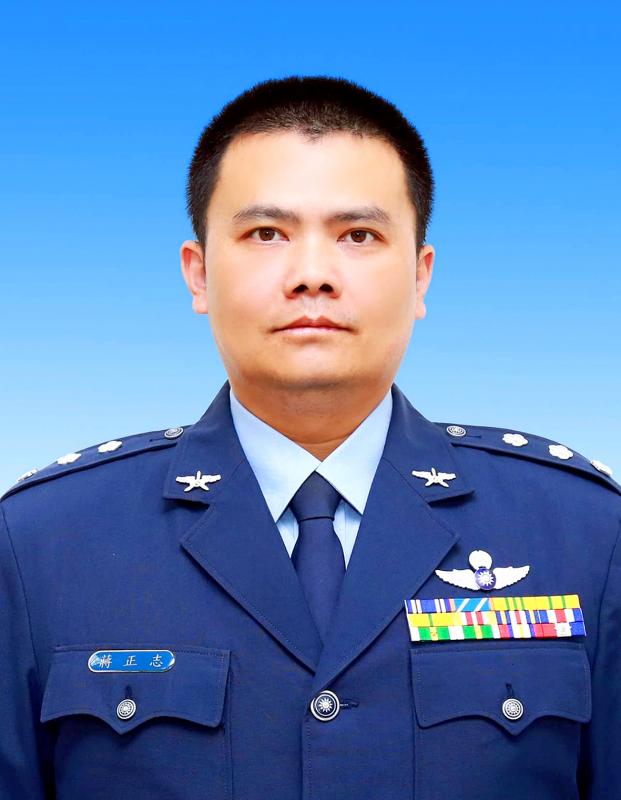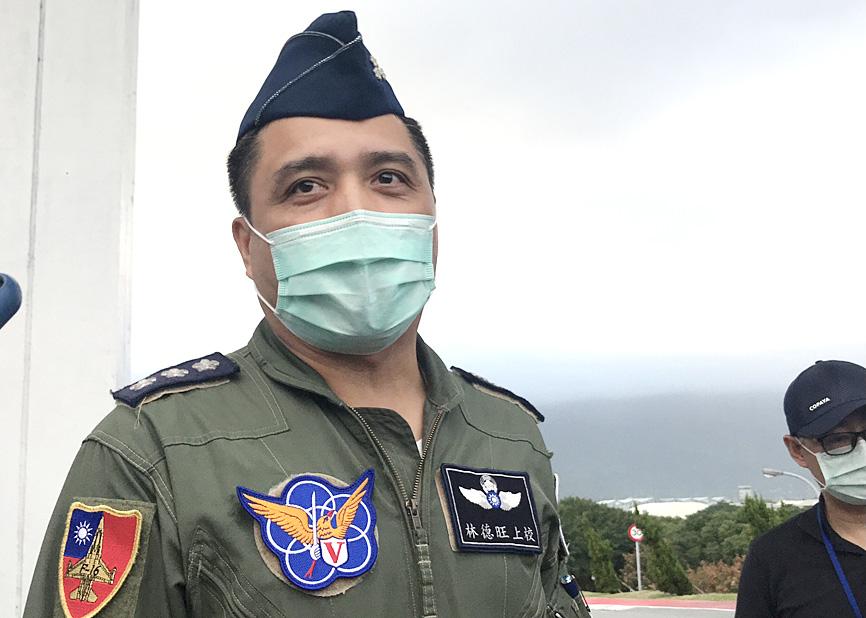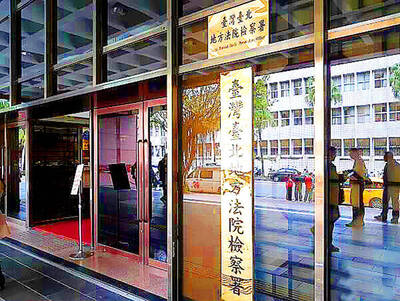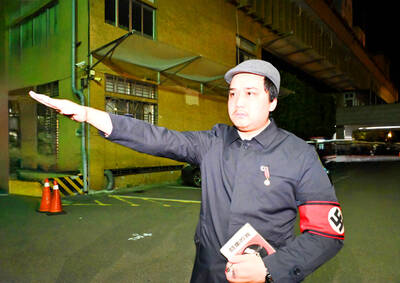An investigation has found no mechanical problems underlying the Tuesday disappearance of an F-16 jet and its pilot, the Ministry of National Defense (MND) said yesterday, adding that it does not rule out an accident due to “spatial disorientation.”
An air force F-16 jet on Tuesday evening disappeared from radar screens, just two minutes after it took off from Hualien Air Base, while the 44-year-old pilot, Colonel Chiang Cheng-chih (蔣正志), has yet to be found.
Minister of National Defense Yen De-fa (嚴德發) yesterday morning headed to Hualien for updates on the search and rescue, while giving a pep talk to Chiang’s unit, the 5th Tactical Fighter Wing.

Photo: Courtesy of Air Force Command Headquarters, MND
The ministry yesterday evening released the preliminary findings of its investigation at a news conference in Taipei.
Radio communications and maintenance records indicate that all systems were normal, and the chance of an accident due to mechanical failure is low, air force Commander General Hsiung Hou-chi (熊厚基) said.
That night it was drizzling, with visibility of about 4 nautical miles (7.5 km), he added.

Photo: CNA
While the jet took off and smoothly rose to an altitude of 2,100m, its altitude had dropped to 1,200m after 14 seconds and to sea level after 20 seconds, he said, citing readings from air force flight radar.
The military does not rule out that the pilot might have experienced spatial disorientation or an optical illusion during the ascent, he said.
Sixteen aircraft and 24 vessels have been mobilized for the search and rescue operation, he said, adding that yesterday morning, a navy vessel intercepted a signal that might have been from the missing jet.
“The military will not give up the hope of bringing Chiang home,” Hsiung said.
All F-16 jets have been grounded and while they are being inspected, Indigenous Defense Fighter jets are covering their duties, Deputy Minister of National Defense Chang Che-ping (張哲平) said earlier yesterday.
Some have said that the incident points to the increased pressure shouldered by the military as there are more frequent incursions by Chinese People’s Liberation Army (PLA) aircraft, but Chang disagreed.
PLA aircraft are typically detected in the nation’s southwest air defense identification zone (ADIZ), so jets are mobilized from bases in Chiayi County or farther south, not from Hualien, Chang said.
Three PLA aircraft — a Y-8 anti-submarine warfare aircraft, a Y-8 electronic warfare aircraft and a Y-9 electronic warfare aircraft — were intercepted in the nation’s southwest ADIZ, military data showed yesterday.
President Tsai Ing-wen (蔡英文) yesterday morning said that the air force has been instructed to conduct a thorough investigation of Tuesday’s incident, with those liable shouldering their share of the responsibility.
The ministry must remain vigilant regarding the nation’s defense, Tsai said, while calling on the public to show their support for the military.
Fifteen military personnel have been lost so far this year in drills or training incidents, including late Chief of the General Staff General Shen Yi-ming (沈一鳴), who was killed in a Black Hawk helicopter crash in New Taipei City on Jan. 2.
Additional reporting by CNA

INVESTIGATION: The case is the latest instance of a DPP figure being implicated in an espionage network accused of allegedly leaking information to Chinese intelligence Democratic Progressive Party (DPP) member Ho Jen-chieh (何仁傑) was detained and held incommunicado yesterday on suspicion of spying for China during his tenure as assistant to then-minister of foreign affairs Joseph Wu (吳釗燮). The Taipei District Prosecutors’ Office said Ho was implicated during its investigation into alleged spying activities by former Presidential Office consultant Wu Shang-yu (吳尚雨). Prosecutors said there is reason to believe Ho breached the National Security Act (國家安全法) by leaking classified Ministry of Foreign Affairs information to Chinese intelligence. Following interrogation, prosecutors petitioned the Taipei District Court to detain Ho, citing concerns over potential collusion or tampering of evidence. The

Seventy percent of middle and elementary schools now conduct English classes entirely in English, the Ministry of Education said, as it encourages schools nationwide to adopt this practice Minister of Education (MOE) Cheng Ying-yao (鄭英耀) is scheduled to present a report on the government’s bilingual education policy to the Legislative Yuan’s Education and Culture Committee today. The report would outline strategies aimed at expanding access to education, reducing regional disparities and improving talent cultivation. Implementation of bilingual education policies has varied across local governments, occasionally drawing public criticism. For example, some schools have required teachers of non-English subjects to pass English proficiency

‘FORM OF PROTEST’: The German Institute Taipei said it was ‘shocked’ to see Nazi symbolism used in connection with political aims as it condemned the incident Sung Chien-liang (宋建樑), who led efforts to recall Democratic Progressive Party (DPP) Legislator Lee Kun-cheng (李坤城), was released on bail of NT$80,000 yesterday amid an outcry over a Nazi armband he wore to questioning the night before. Sung arrived at the New Taipei City District Prosecutors’ Office for questioning in a recall petition forgery case on Tuesday night wearing a red armband bearing a swastika, carrying a copy of Adolf Hitler’s Mein Kampf and giving a Nazi salute. Sung left the building at 1:15am without the armband and apparently covering the book with a coat. This is a serious international scandal and Chinese

TRADE: The premier pledged safeguards on ‘Made in Taiwan’ labeling, anti-dumping measures and stricter export controls to strengthen its position in trade talks Products labeled “made in Taiwan” must be genuinely made in Taiwan, Premier Cho Jung-tai (卓榮泰) said yesterday, vowing to enforce strict safeguards against “origin laundering” and initiate anti-dumping investigations to prevent China dumping its products in Taiwan. Cho made the remarks in a discussion session with representatives from industries in Kaohsiung. In response to the US government’s recent announcement of “reciprocal” tariffs on its trading partners, President William Lai (賴清德) and Cho last week began a series of consultations with industry leaders nationwide to gather feedback and address concerns. Taiwanese and US officials held a videoconference on Friday evening to discuss the